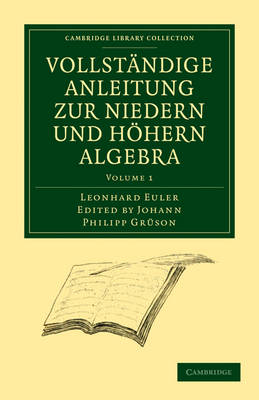Cambridge Library Collection - Mathematics
2 primary works • 4 total works
Volume 1
Vollstandige Anleitung zur Niedern und Hoehern Algebra: Volume 1
by Leonhard Euler
Published 20 July 2009
In 1770, one of the founders of pure mathematics, Leonard Euler (1707-1783), published an algebra textbook for students. It was soon translated into French, with notes and additions by Joseph-Louis Lagrange, another giant of eighteenth-century mathematics, and the French edition was used as the basis of the English edition of 1822 (which also appears in this series), and of this 1790s German edition by Johann Philipp Gruson, Professor of Mathematics to the royal cadets. Volume 1 begins with elementary mathematics of determinate quantities and includes four sections on simple calculations (addition, subtraction, division, multiplication), and progresses to compound calculations (fractions), ratios and proportions. This landmark book showed students the beauty of mathematics, and more significantly, how to do it. It provides tangible evidence of the lively and international mathematical community that flourished despite the political uncertainties of the late eighteenth century.
Volume 2
Vollstandige Anleitung zur Niedern und Hoehern Algebra: Volume 2
by Leonhard Euler
Published 20 July 2009
In 1770, one of the founders of pure mathematics, Leonard Euler (1707-1783), published an algebra textbook for students. It was soon translated into French, with notes and additions by Joseph-Louis Lagrange, another giant of eighteenth-century mathematics, and the French edition was used as the basis of the English edition of 1822 (which also appears in this series), and of this 1790s German edition by Johann Philipp Gruson, Professor of Mathematics to the royal cadets. Volume 2 consists of two parts: 16 chapters on algebraic equations, followed by 15 chapters on analyses of indeterminate quantities. Here, Euler shows the reader several ways to solve polynomial equations up to the fourth degree. This landmark book showed students the beauty of mathematics, and more significantly, how to do it. It provides tangible evidence of the lively international mathematical community that flourished despite the political uncertainties of the late eighteenth century.
Vollstandige Anleitung zur Niedern und Hoehern Algebra 3 Volume Paperback Set
by Leonhard Euler
Published 24 September 2009
In 1770, one of the founders of pure mathematics, Leonard Euler (1707-1783), published an algebra textbook for students. It was soon translated into French, with notes and additions by Joseph-Louis Lagrange, another giant of eighteenth-century mathematics, and the French edition was used as the basis of the English edition of 1822 (which also appears in this series), and of this 1790s German edition by Johann Philipp Gruson, Professor of Mathematics to the royal cadets. This set brings together volume 1 which begins with elementary mathematics of determinate quantities and includes four sections on simple calculations and progresses to compound calculations, ratios and proportions, and volume 2 which consists of two parts: 16 chapters on algebraic equations, followed by 15 chapters on analyses of indeterminate quantities.
Vollstandige Anleitung zur Niedern und Hoehern Algebra: Volume 3
by Leonhard Euler
Published 5 March 2012
In 1770, one of the founders of pure mathematics, the Swiss-born mathematician Leonard Euler (1707-1783), published an algebra textbook for students. It was soon translated into French, with notes and additions by Joseph-Louis Lagrange, another giant of eighteenth-century mathematics, and the French edition was used as the basis of this three-volume 1790s German edition. Volume 3 consists of the German translation of Lagrange's additional material, which the German publisher printed in a separate volume to enable those who already owned Euler's Algebra to obtain the supplementary material 'without incurring unnecessary expenditure'. The translator (the tutor to the sons of the Duke of Wurttemberg) added notes and further appendices of his own. This book provides tangible evidence of the lively international mathematical community that flourished despite the political uncertainties of the late eighteenth century.

